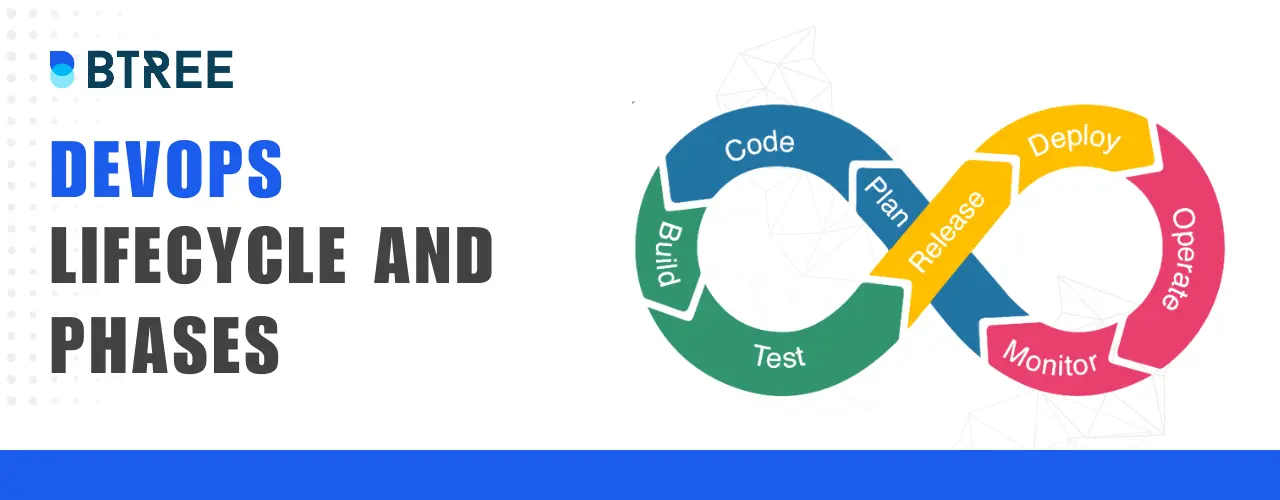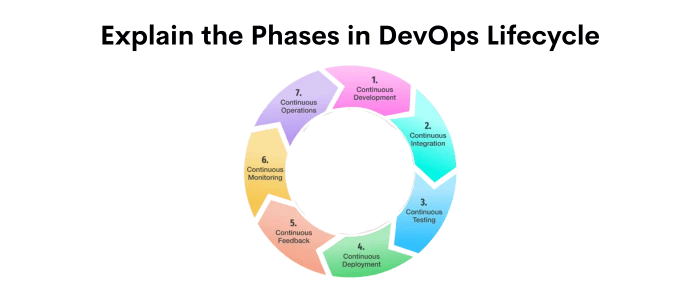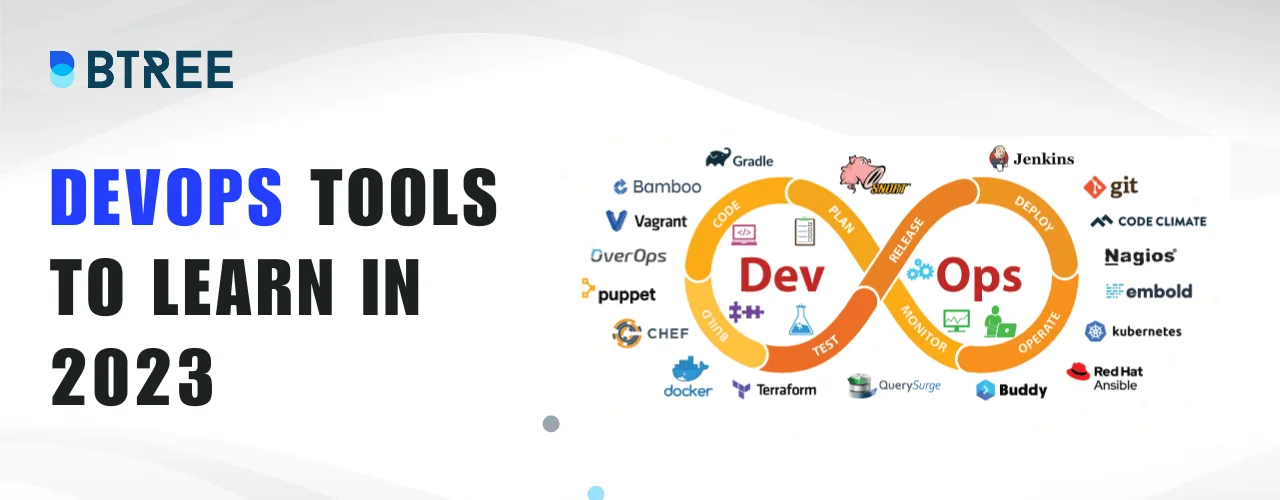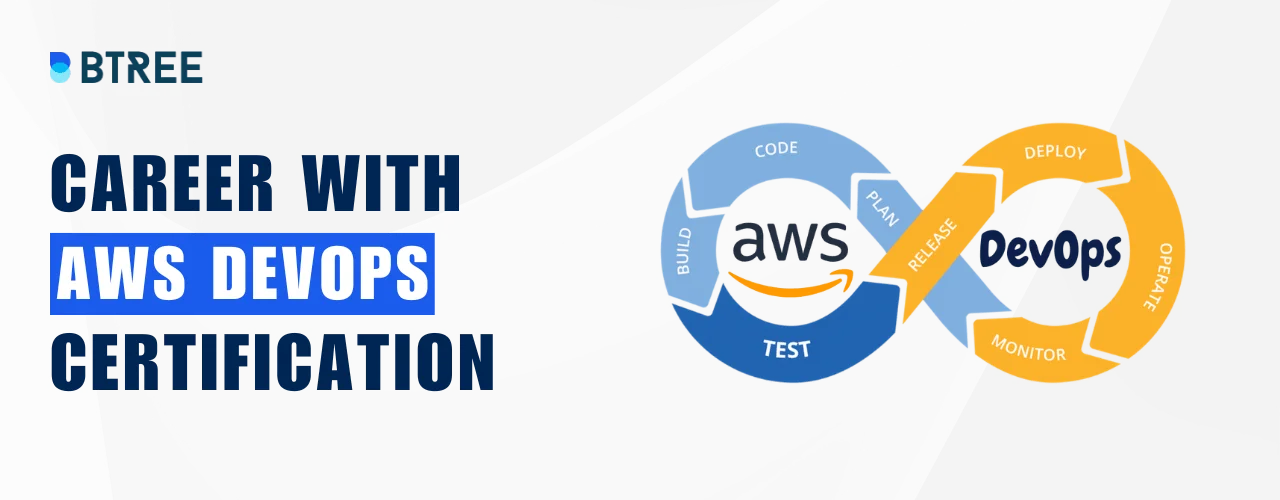
Introduction to DevOps Lifecycle
The DevOps lifecycle encompasses practices and principles. It promotes collaborative efforts between development and operations teams for better software delivery. This systematic approach combines various practices, tools, and methodologies to streamline software development. DevOps aims to break down the traditional barriers between these critical functions. This results in promoting close cooperation, communication, and automation.
Throughout this blog, we will explore each stage of the DevOps lifecycle and phases. We will unveil the key strategies and cost optimization strategies. Drive organizations to achieve faster delivery cycles and improved software quality.
What is DevOps?

DevOps refers to a software development approach. It combines the efforts of development (Dev) and operations (Ops) teams. It enhances collaboration and streamlines the software delivery process. Moreover, it emphasizes continuous integration, delivery, and deployment (CI/CD). It leads to promoting rapid and reliable software releases.
DevOps enables a culture of shared responsibility and close collaboration. It allows organizations to deliver software faster, with higher quality and greater efficiency.
What is DevOps Lifecycle?

The DevOps lifecycle is the journey that software goes through. It starts from its creation and continues through deployment and beyond. It occurs in an environment where development and operations work together. The lifecycle consists of stages: development, integration, testing, monitoring, feedback, deployment, and procedures.
Each phase focuses on making iterative improvements and fostering close coordination between teams. The DevOps lifecycle enables organizations to have agile and reliable software. It ensures that it meets the changing needs of users and aligns with the business objectives.
Unlock the power of AWS DevOps and propel your career to new heights. Join now to secure your spot in our expert-curated course!
Importance of DevOps Lifecycle
The DevOps lifecycle plays a significant role in modern software development and delivery. Here we pointed out some of the key reasons why it is essential:
Accelerated Development
- DevOps practices emphasize automation, collaboration, and continuous integration and deployment.
- The lifecycle enables faster software development cycles by integrating development and operations teams.
- It allows organizations to respond to market demands and gain a competitive edge.
Enhanced Collaboration
- DevOps promotes cross-functional collaboration between development, operations, and other stakeholders.
- It breaks down barriers and fosters a culture of collaboration and knowledge sharing.
- This collaborative environment leads to better communication, increased efficiency, and improved software quality.
Continuous Integration and Deployment
- The DevOps lifecycle encourages adopting continuous integration and deployment practices.
- Developers get encouraged to integrate their code into a shared repository.
- Then, it undergoes automated testing and building procedures.
- Continuous deployment further automates the software deployment process.
- It enables the organizing and release of software updates.
- It minimizes the chances of errors and promotes regular and predictable software releases.
Improved Quality and Stability
- DevOps principles, such as automated testing, help ensure software quality.
- Continuous monitoring allows real-time visibility into the application's performance and health.
- Rigorous testing practices throughout the lifecycle identify and fix issues early.
Increased Efficiency and Productivity
- DevOps practices automate repetitive tasks, freeing up teams for more value-added activities.
- Automated processes cut human errors and shorten the time and effort required.
- Higher efficiency leads to higher productivity and effective software delivery.
Improved Customer Satisfaction
- Faster delivery of new features and updates addresses customer needs and feedback.
- Continuous feedback loops and monitoring provide valuable insights into user behavior.
- Incorporating customer feedback and continuous improvement enhances satisfaction and trust.
Agility and Flexibility
- DevOps methodologies empower organizations to respond to changing requirements.
- The iterative nature of the lifecycle allows for flexibility and adaptation.
- Automated infrastructure provisioning enables quick scalability and resource change.
Cost Optimization
- The DevOps lifecycle optimizes costs throughout software development and delivery.
- Automation reduces manual interventions and minimizes rework.
- Efficient processes and productivity result in cost savings and improved resource use.
Enhance your expertise with our expert-led Azure DevOps Certification Course. Gain the skills to optimize software delivery and drive your career forward!
Our Lovely Student feedback
Explain the DevOps Lifecycle and Phases

The DevOps lifecycle comprises several phases like Development, Integration, Testing, Monitoring, Feedback, Deployment, and Operations. Each phase has a unique purpose and uses specific tools to achieve its objectives. Let's explore each stage and the associated tools of DevOps Lifecycle
1. Development Phase
The Development phase focuses on creating and improving software applications. Developers write code and collaborate on designing features and functionalities. They use various tools and technologies to streamline the development process. This phase focuses on getting fast feedback and improves by doing things repeatedly.
Tools Used:
IDEs are tools such as Visual Studio Code, IntelliJ IDEA, and Eclipse. They offer features that help with coding, debugging, and version control. VCS, such as Git, Mercurial, and Subversion, helps developers handle and follow codebase changes.
2. Integration Phase
Developers merge code changes in a shared place called a repository for smooth collaboration. It is known as integration. Continuous Integration (CI) tools automate this process, allowing developers to integrate their changes. Integrating code can catch issues early, lowering the chance of bugs in software.
Tools Used:
Jenkins, Travis CI, and CircleCI help developers merge their code. These tools make it easy to combine changes in a shared place and start automatic tests and builds. Developers use CI tools to connect code changes and check if the code works. The tools confirm the quality and functionality of the new combined code.
3. Testing Phase
The software evaluation team conducts tests during the testing phase. It is to identify bugs, errors, or unexpected behavior. They perform unit tests. It verifies individual components and integration tests to check interactions between parts. Automated testing frameworks and tools are used to execute tests and provide quick feedback to developers.
Tools Used:
Unit Testing Frameworks
Tools like JUnit (Java), pytest (Python), and NUnit (.NET) enable developers to write and run automated unit tests. It is used to verify the functionality of code components.
Functional Testing Tools
Selenium and Puppeteer are used for automated functional testing. They allow developers to simulate user interactions and confirm application behavior.
Load Testing Tools
Apache JMeter, Gatling, and Locust help simulate high user loads. It is to stress test applications and assess performance and scalability.
Embrace DevOps excellence and elevate your career to new heights with BTree Systems' industry-leading DevOps Training Course.
4. Monitoring Phase
Monitoring is a crucial aspect of DevOps. It involves tracking the real-time performance and health of the software. Monitoring tools collect data on metrics such as response time, resource use, and error rates. This information helps find problems and makes sure the system works okay. Monitoring enables proactive issue identification and resolution, improving reliability and user experience.
Tools Used:
Application Performance Monitoring (APM) Tools
New Relic and AppDynamics provide a real-time user experience.
Log Management Tools
ELK Stack, Splunk, and Graylog help collect and analyze application logs. It is for efficient troubleshooting and root cause analysis.
5. Feedback Phase
Feedback plays a vital role in the DevOps lifecycle. It involves gathering insights and suggestions from stakeholders. It includes end-users, developers, testers, and operations teams.
It helps identify areas for improvement and confirm whether the software meets requirements. Continuous feedback loops ease collaboration and communication. It leads to ensuring that the software meets evolving needs and expectations.
Tools Used:
Collaboration and Communication Tools
Jira, Trello, and Asana ease collaboration among development teams. It allows them to manage tasks, track progress, and provide feedback on features and issues.
User Feedback Tools
UserVoice, Usabilla, and SurveyMonkey enable gathering end-user feedback. It is possible through surveys, feedback forms, and usability testing.
6. Deployment Phase
Deployment refers to releasing the software to production environments. It involves testing and validating code and making it available for end-users. DevOps emphasizes automation in deployment to achieve repeatability and consistency. Continuous Deployment (CD) practices enable frequent and reliable releases. It ensures reducing the time it takes to deliver new features and bug fixes. Automated deployment pipelines streamline the process, including building, packaging, and configuring the software.
Tools Used:
Configuration Management Tools
Tools such as Ansible, Chef, and Puppet automate the configuration of infrastructure resources. They ensure consistent and reproducible deployments.
Containerization and Orchestration Tools
Docker and Kubernetes provide a robust ecosystem for packaging applications into containers. It manages their deployment, scaling, and management across clusters.
7. Operations Phase
The operations phase focuses on maintaining and managing the software in production. Operations teams check the deployed application, manage infrastructure, and handle incidents. They ensure the system is available, performant, and secure.
DevOps encourages collaboration between developers and operations teams. It is to enable shared responsibilities and faster resolution of issues. Automation tools and infrastructure-as-code practices help infrastructure provisioning and configuration management
Tools Used:
Infrastructure-as-Code (IaC) Tools
Terraform and AWS CloudFormation enable the creation of infrastructure resources using declarative code. It ensures infrastructure consistency and reproducibility.
Continuous Delivery (CD) Tools
The deployment process is automated by Spinnaker, AWS CodePipeline, and GitLab CI/CD. It enables organizations to release more reliable software.
You now have a comprehensive understanding of DevOps Lifecycle and phases also the tools that are associated with them. In the next section, we will explore strategies mainly aimed at managing costs at each stage of the DevOps lifecycle. These strategies will provide valuable insights. Moreover, you can gain practical guidance to optimize costs in your DevOps practices.
So, let's delve into the cost management strategy throughout the stages of the DevOps lifecycle.
Best Practices and Strategies for Implementing DevOps Lifecycle
Implementing a successful DevOps lifecycle is crucial. It is for organizations seeking to enhance collaboration, efficiency, and software delivery speed. Specific best practices and strategies must be adopted to ensure efficient implementation.
Below are some essential practices and strategies for implementing the DevOps lifecycle.
Define Clear Goals and Objectives
Before implementing DevOps, organizations must establish clear goals and objectives. Identify the pain points in your software development processes. Also, determine what you want to achieve through DevOps implementation. Clear goals will guide the entire implementation process and help measure success
Foster a Culture of Collaboration
DevOps is not just a set of tools but a cultural shift emphasizing collaboration and shared responsibility. Encourage collaboration and communication between development, operations, and other relevant teams.
Foster an environment where feedback is valued. And cross-functional teams can work seamlessly together.
Automation
Automation plays a pivotal role in DevOps. Automate repetitive tasks such as builds, tests, and deployments to reduce human error.
Use configuration management and deployment automation to enable faster and more reliable releases. Automation frees up valuable time for teams to focus on innovation and problem-solving.
Continuous Integration and Continuous Delivery (CI/CD)
Implement CI/CD pipelines for continuous integration, testing, and software delivery. CI/CD pipelines automate the process of building, testing, and deploying code changes.
It enables faster feedback loops and reduces time to market. Ensure the CI/CD pipeline is well-designed, modular, and flexible. It allows easy integration with different tools and technologies.
Infrastructure as Code (IaC)
Adopt Infrastructure as Code to manage programmatically and provision infrastructure resources. IaC provides for version control, reproducibility, and consistency in infrastructure deployments.
Tools such as Terraform and Ansible can help automate the provisioning. And the infrastructure configuration ensures consistency across development, testing, and production environments.
Monitoring and Feedback Loops
Establish a robust monitoring strategy. It will help gain insights into application performance and system behavior. Implement real-time monitoring and alerting mechanisms to identify and address issues proactively.
Leverage tools like Prometheus, ELK Stack, or Datadog for comprehensive monitoring. Feedback loops from production environments to development teams. It helps to drive continuous improvement and quality enhancement.
Security and Compliance
Embed security practices throughout the software development lifecycle. Implement security testing, vulnerability scanning, and code analysis tools. It will be beneficial to identify and remediate security issues early on.
Also, incorporate security practices into the CI/CD pipeline to ensure security is integral to the release process. Follow industry regulations and standards to protect data privacy and sensitive information.
Continuous Learning and Improvement
Encourage a continuous learning and improvement culture. It will enable an environment where individuals feel safe to experiment and learn from failures. Moreover, invest in training and upskilling programs by industry experts. Try to keep teams updated with the latest tools and technologies.
Collaboration and Communication
Promote collaboration and effective communication between teams and stakeholders. Use collaboration tools like Slack, Microsoft Teams, or Jira. It will allow you to ease communication and information sharing.
Foster a transparent culture where individuals are encouraged. It will result in them taking ownership and collaborating on problem-solving.
How to Manage Costs at Every Stage of the DevOps Lifecycle?
Optimizing and managing the cost during implementation is crucial at every stage. Organizations can maximize value while minimizing expenses by optimizing costs throughout the process.
1. Development Stage:
Define Clear Objectives
Project goals and requirements to prevent scope creep and unnecessary costs.
Agile Development Practices
Utilize agile methodologies like Scrum or Kanban. It enables prioritizing the features and delivering value iteratively. It minimizes rework and reduces costs associated with extended development cycles.
2. Integration Stage:
Continuous Integration (CI)
Implement CI practices to merge code changes frequently. It enables early bug detection and reduces the cost of fixing issues in later stages.
Automated Testing
Employ tools and frameworks to detect bugs and compatibility issues early on. It helps reduce the overall cost of testing and bug fixing.
3. Testing Stage:
Test Environment Optimization
Use virtualization or containerization technologies to create efficient and scalable test environments. It minimizes hardware costs and improves resource utilization
Test Data Management
Generate and manage realistic test data efficiently. It ensures comprehensive coverage while minimizing storage costs.
4. Monitoring Stage:
Effective Monitoring Tools
Invest in monitoring tools that provide real-time insights into system performance and resources. It helps identify and resolve issues promptly, preventing costly downtimes.
Right-sizing Resources
Analyze resource use data and optimize infrastructure provisioning to match requirements. It prevents over-provisioning and wasteful spending on unnecessary resources.
5. Feedback Stage:
Collaborative Communication
Foster open communication between developers, testers, and operations teams. It will enable prompt feedback and issue resolution. It avoids costly delays and rework.
User Feedback Collection
Put in place mechanisms to gather user feedback, such as surveys or user testing sessions. It helps prioritize features and reduces the cost of developing irrelevant functionalities.
6. Deployment Stage:
Automation and Orchestration
Use deployment automation and orchestration tools to streamline the deployment process. It reduces manual effort, minimizes errors, and saves time and costs.
Blue-Green Deployments
Implement blue-green deployment strategies to minimize downtime during releases. It seamlessly enables rollback to the previous version in case of issues. It will prevent potential revenue losses.
7. Operations Stage:
Infrastructure Optimization
Always check and optimize infrastructure usage. It allows efficient resource allocation and cost savings.
Predictive Analytics
To anticipate potential system failures or resource bottlenecks, utilize predictive analytics. This proactive approach helps prevent costly incidents and optimize resource allocation.
Conclusion
In conclusion, DevOps is a transformative approach that serves as the bridge. It connects development and operations teams throughout the software development lifecycle. Overall, we have explored the fundamentals and importance of the DevOps lifecycle. And we hope you indeed understand that it goes beyond just a set of tools.
The DevOps Lifecycle consists of various phases. Each is vital in achieving continuous integration and deployment. Organizations can implement DevOps and streamline their operations. It is possible by adopting best practices and strategies. Moreover, managing costs at every stage ensures efficient resource allocation. It will indeed optimize the budget usage.
By adopting the DevOps Lifecycle, companies can advance innovation. It will help them succeed in today's dynamic business landscape.
Course Schedule
| Name | Date | Details |
|---|---|---|
| Azure DevOps Training |
26 Aug 2023
(Sat-Sun) Weekend Batch |
View Details |
| AWS DevOps Training |
02 Sept 2023
(Sat-Sun) Weekend Batch |
View Details |
| Microsoft Azure Training |
09 Sept 2023
(Sat-Sun) Weekend Batch |
View Details |
Looking For 100% Salary Hike?
Speak to our course Advisor Now !









